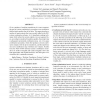Free Online Productivity Tools
i2Speak
i2Symbol
i2OCR
iTex2Img
iWeb2Print
iWeb2Shot
i2Type
iPdf2Split
iPdf2Merge
i2Bopomofo
i2Arabic
i2Style
i2Image
i2PDF
iLatex2Rtf
Sci2ools
ICASSP
2010
IEEE
2010
IEEE
Hypothesis ranking and two-pass approaches for machine translation system combination
Given a number of machine translations of a source segment, the goal of system combination is to produce a new translation that has better quality than all of them. This paper describes a number of improvements that were recently added to the JHU system combination scheme: (i) A hypothesis ranking technique which orders the system outputs, on a per-segment basis, according to predicted translation quality, thus improving a subsequent incremental combination step. (ii) A two-pass combination procedure, which first produces several combination outputs with the given translations, and then performs one more combination step with these new outputs. Results from the NIST MT09 informal system combination evaluation on Arabic-to-English and Urdu-to-English1 show that both approaches offer significant BLEU and TER gains over a baseline JHU combination scheme.
Combination Scheme | Combination Step | ICASSP 2010 | Signal Processing | Subsequent Incremental Combination |
| Added | 06 Dec 2010 |
| Updated | 06 Dec 2010 |
| Type | Conference |
| Year | 2010 |
| Where | ICASSP |
| Authors | Damianos Karakos, Jason Smith, Sanjeev Khudanpur |
Comments (0)

